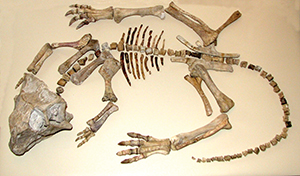By Linda Bentley | MARCH 2, 2016
Canadian sentenced for smuggling dinosaur fossils from China
‘Paleontologists are cautious about a sample obtained from fossil smugglers’
TUCSON – Last week Jun Yang, 36, a resident of Richmond, British Columbia, Canada, was sentenced by U.S. District Judge Cindy K. Jorgenson to five years of probation and a $25,000 fine after pleading guilty last year to illegally removing dinosaur and egg fossils from China, which he smuggled in shipping containers to the United States.
Yang, president of Arctic Products, Inc., was attempting to sell a Psittacosaurus fossil for $15,000 and 16 Hadrosaur egg fossils for $450 apiece during the 2015 Tucson Gem and Mineral Show.
 Psittacosaurus
Psittacosaurus
Yang entered a plea agreement last August to the smuggling charge, in violation of 18 USC Section 545, a class C felony, whereas he knowingly received, concealed, bought or sold, or facilitated in any manner the transportation, concealment or sale of any merchandise previously imported contrary to law.
An item is imported contrary to law if the item should have been invoiced.
As a factual basis for his guilty plea, Yang admitted he knowingly received, transported and sold 15 Hadrosaur dinosaur egg fossils and offered for sale one Psittacosaurus fossil, all smuggled into the United States from China.
Yang said he traveled from Canada to Tucson to display and sell the fossils during the February 10-14, 2015 Globe-X Gem and Mineral Show.
Prominently displaying the items he advertised and represented as a Psittacosaurus fossil and 16 Hadrosaur egg fossils, Yang told customers, whom he later learned were undercover ICE officers acting as buyers, that the eggs were Chinese dinosaur fossils and “duck billed.”
Yang said he told other customers, whom he later learned were also undercover agents, that the Psittacosaurus was from the Henan Province of China, was 100 to 130 million years old, was for sale for $15,000 and was a very fine piece – intact and complete.
Back in January 2002, China.org.cn published an article by Yan Hong titled “When Will the Fossil Smuggling End?”
Stating a fossil records the history of life, Hong said, “The discovery and excavation of fossils are of great significance to understanding the evolution of earth and studying the ancient geography, paleoclimate and conditions for forming minerals.”
Hong said a picture that was arousing world attention was that of a fossil of a Psittacosaurus.
After years of being underground, the photo was emailed by a Canadian fossil distributor to those on a Dinosaur e-mail list.
He said what made the fossil unique was that there was a cluster of bristles at the tip of its tail and if the Psittacosaurus was proven to have feathers, it would be great progress in dinosaur studies.
However, he noted, up until that point, the fossil had never been mentioned in any conferences or articles and the photo of the fossil had only been shown to a few people at the annual vertebrate meeting of North America years earlier.
Hong stated, “Paleontologists are cautious about a sample obtained from fossil smugglers.”
Mark Norell, from the American Museum of Natural History in New York, who is an expert in Asian dinosaurs, said private fossil trading usually hides the significance of scientific discoveries and no example is more convincing than the Psittacosaurus.
Norell said, “The sample may change our knowledge about dinosaurs, but we can confirm nothing at present, for nobody has studied or published the relic. The fossil should be returned to China, to Chinese museums where people can study it.”
Zhou Zhonghe, a researcher with the Institute of Vertebrate Paleontology and Paleoanthropology under Chinese Academy of Sciences believed the Psittacosaurus fossil might have been smuggled out of China several years earlier.
Zhonghe said fossils need protection to protect science and natural cultural heritage and stated established museums worldwide don’t want to have any connection with a smuggled fossil, as they are not permitted to get involved with fossils of unknown origin.
Hong concluded immediate attention needed to be given to strengthen fossil bed protection, enhance the legal system regarding fossil protection and prevent reckless excavation and smuggling of fossils.
In April 2007, a warning was posted on ebay.com: “Beware of fossil Psittacosaurus skeletons.”
The warning stated, “Many guides have been written about the dangers of Chinese fossils before, especially relating to dinosaur eggs. However one glaring omission from most discussions is the proliferation of fake Psittacosaurus fossils. Many of these specimens are perfect looking animals that are splayed out on a piece of matrix with no missing parts, all the claws and vertebrae intact and without blemishes. Almost every single one of these specimens are fake! No dinosaur fossil has ever been found like that. Ever. Even the famous ‘fighting dinosaurs’ specimen, or the feathered dinosaurs of Liaoning, or even animals like Archeopteryx were all incomplete. The most complete dinosaur ever found came from Montana, a Brachylophosaurus specimen that was 99% complete. Even with its remarkable preservation, it was still missing bones.”
The warning went on to state, “Again it bears mentioning that all fossils (with the exception of some fish fossils) are illegal to export or sell from China. So if your seller is shipping from China, chances are you’re getting a fake, or they’re smuggling it out illegally.”
The poster, no longer a registered user on ebay, stated he was a professional paleobiologist and member of the Society of Vertebrate Paleontology.
He said, “I feel that the public has a right to own nonscientifically-important fossils. It’s a great way to get the public interested and excited about the ancient past of our planet. But the public should also be sure that they’re actually getting a fossil and not getting duped out of hundreds or thousands of dollars.”
So that brings up the question of whether the fossils were actually real fossils smuggled in from China or fake.
While court documents indicated no restitution was ordered, they didn’t address what was to become of the fossils.


